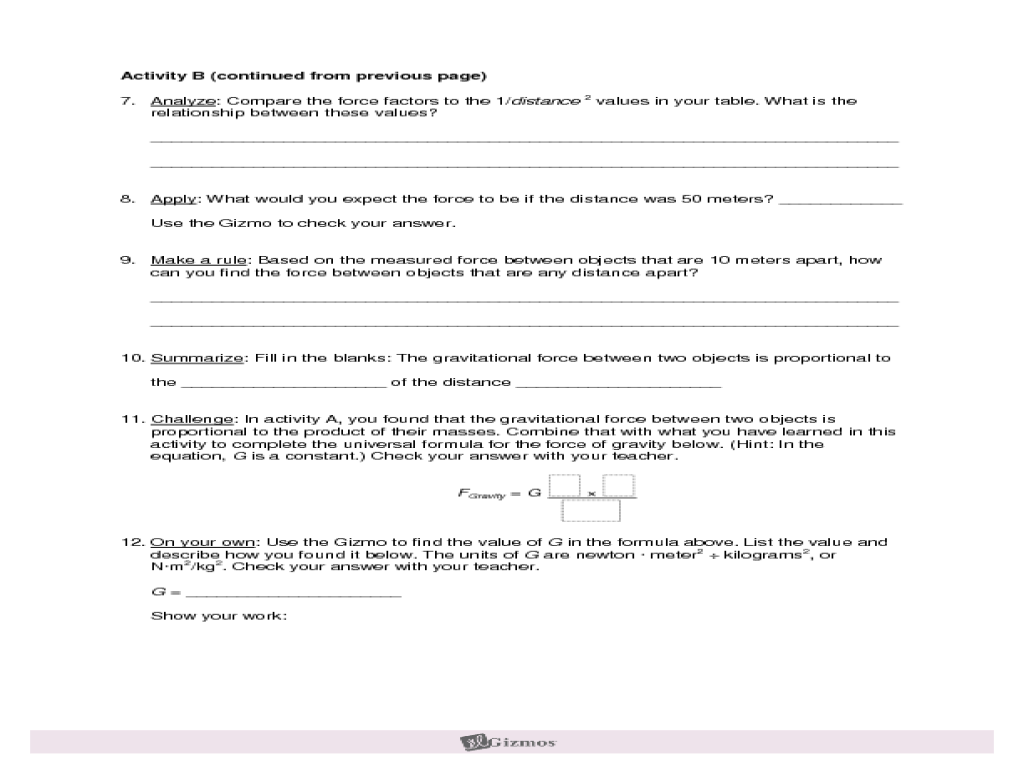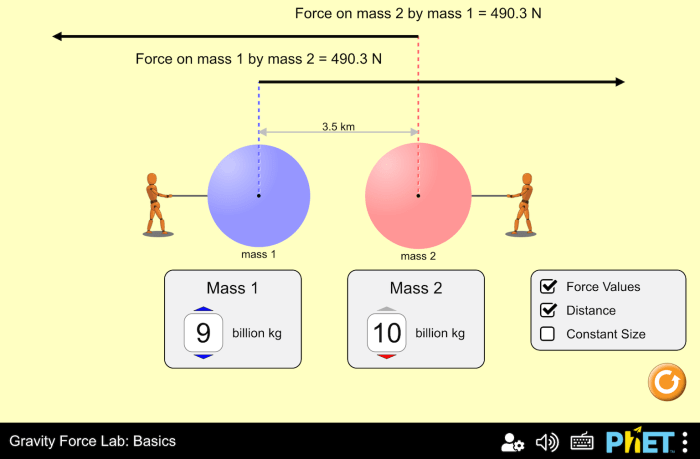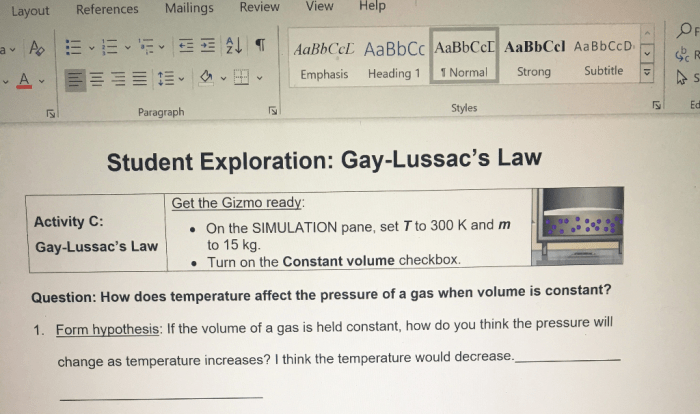Embark on an enlightening journey with our gravitational force gizmo answer key, an invaluable resource that unlocks the mysteries of this fundamental force. This comprehensive guide delves into the depths of gravitational force, empowering you with a thorough understanding of its concepts, applications, and implications.
Our exploration begins with a lucid definition of gravitational force, followed by an in-depth examination of its formula and components. We then guide you through the intricacies of the Gizmo simulation, providing step-by-step instructions for setting up and running the simulation to gather valuable data.
Gravitational Force Definition and Formula
Gravitational force is the force of attraction between two objects with mass. It is a fundamental force in the universe that governs the motion of planets, stars, and galaxies.
The formula for gravitational force is:
$$F = G \fracm_1 m_2r^2$$
- F is the gravitational force in newtons (N)
- G is the gravitational constant, which is approximately 6.674 × 10 -11N m 2kg -2
- m 1and m 2are the masses of the two objects in kilograms (kg)
- r is the distance between the centers of the two objects in meters (m)
Gizmo Simulation Introduction

The Gravitational Force Gizmo is an interactive simulation that allows students to explore the concepts of gravitational force and its effects on objects.
To set up the simulation, students select the objects they want to interact with from the menu on the left. They can then drag and drop the objects onto the simulation stage and adjust their masses and positions. Once the objects are in place, students can click the “Play” button to run the simulation.
Controls
- Object Menu:Select the objects to interact with from the menu on the left.
- Drag and Drop:Drag and drop the objects onto the simulation stage to position them.
- Mass Slider:Adjust the mass of each object using the slider on the right.
- Play/Pause Button:Click the “Play” button to run the simulation and the “Pause” button to stop it.
Observations
When the simulation is running, students can observe the following:
- The objects will move according to the laws of gravity.
- The force of gravity between two objects is directly proportional to their masses and inversely proportional to the square of the distance between them.
- The direction of the force of gravity is always towards the center of mass of the two objects.
Gizmo Simulation Data Analysis

The Gizmo simulation allows you to collect data on the gravitational force between two objects. You can use this data to plot a graph of the gravitational force as a function of the distance between the objects.
To collect data from the simulation, follow these steps:
- Open the Gizmo simulation.
- Set the mass of the first object to 1 kg.
- Set the mass of the second object to 1 kg.
- Set the distance between the objects to 1 m.
- Click the “Play” button.
- Record the gravitational force between the objects in the table.
- Repeat steps 5 and 6 for several different distances between the objects.
Once you have collected data from the simulation, you can plot a graph of the gravitational force as a function of the distance between the objects. To do this, follow these steps:
- Open a graphing program.
- Enter the data from the table into the graphing program.
- Select the “Scatter Plot” option.
- Click the “Plot” button.
The graph will show the relationship between the gravitational force and the distance between the objects. You can use the graph to identify trends in the data.
Plotting the Data and Identifying Trends
The graph of the gravitational force as a function of the distance between the objects will show a decreasing trend. This means that the gravitational force between the objects decreases as the distance between the objects increases.
The slope of the graph can be used to calculate the gravitational constant. The gravitational constant is a constant that is used to calculate the gravitational force between two objects.
$$F_g = G\fracm_1m_2r^2$$
where:
- $F_g$ is the gravitational force between the objects in newtons (N)
- $G$ is the gravitational constant ($6.674 × 10^-11 \text N\cdot\textm^2/\textkg^2$)
- $m_1$ is the mass of the first object in kilograms (kg)
- $m_2$ is the mass of the second object in kilograms (kg)
- $r$ is the distance between the objects in meters (m)
Factors Affecting Gravitational Force
Gravitational force is a fundamental force that exists between any two objects with mass. The strength of this force is determined by the masses of the objects and the distance between them.
The following factors affect the strength of gravitational force:
- Mass: The greater the mass of an object, the greater its gravitational force.
- Distance: The greater the distance between two objects, the weaker the gravitational force between them.
The relationship between gravitational force, mass, and distance is described by the following equation:
F = G
- (m1
- m2) / r^2
Where:
- F is the gravitational force
- G is the gravitational constant (6.674 × 10^-11 N m^2 kg^-2)
- m1 and m2 are the masses of the two objects
- r is the distance between the two objects
The following table compares the effects of different factors on gravitational force:
| Factor | Effect on Gravitational Force |
|---|---|
| Mass | Increases gravitational force |
| Distance | Decreases gravitational force |
Real-World Applications: Gravitational Force Gizmo Answer Key
Gravitational force plays a crucial role in various aspects of our lives, affecting objects on Earth and beyond.
Understanding gravitational force is essential in fields such as:
Astronomy and Astrophysics, Gravitational force gizmo answer key
- Determining the motion of celestial bodies, such as planets, moons, and stars
- Understanding the formation and evolution of galaxies
- Calculating the gravitational lensing effect
Engineering and Architecture
- Designing bridges, buildings, and other structures that withstand gravitational forces
- Calculating the stability of dams and other structures
- Understanding the effects of gravitational forces on materials
Geophysics and Geology
- Studying the Earth’s gravitational field and its variations
- Exploring the Earth’s interior and crustal movements
- Understanding the formation and dynamics of mountains and volcanoes
Navigation and Space Exploration
- Calculating the trajectories of rockets, satellites, and spacecraft
- Determining the position and velocity of ships and aircraft
- Understanding the effects of gravitational forces on astronauts and space vehicles
FAQ Overview
What is the formula for gravitational force?
F = G – (m1 – m2) / r^2
What is the purpose of the Gizmo simulation?
The Gizmo simulation allows users to visualize and investigate the effects of gravitational force on various objects.
How can I use the Gizmo simulation to analyze data?
You can collect data from the simulation by recording the positions and velocities of the objects over time. You can then plot the data to identify trends and relationships.
What factors affect gravitational force?
The mass of the objects and the distance between them.
What are some real-world applications of gravitational force?
Gravitational force is responsible for keeping planets in orbit around the sun, tides, and the motion of objects on Earth.

